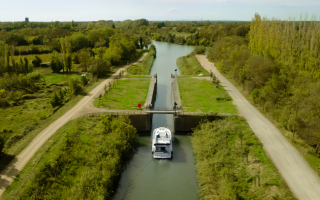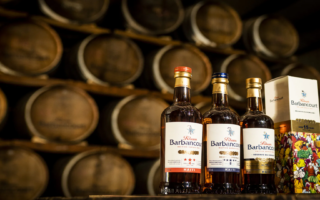That’s the spirit
France may be known for its wine and champagne, but have you ever raised a glass with one of its other tipples? Each region boasts a liqueur, spirit or fortified wine with a story to tell. Here’s a list of our 20 favourite ones to try
France may be known for its wine and champagne, but have you ever raised a glass with one of its other tipples? Each region boasts a liqueur, spirit or fortified wine with a story to tell. Here’s a list of our 20 favourite ones to tryPastisIf you have a glass of pastis in one hand, chances are that in the other, you’ll have a boule. For this refreshing aniseed-flavoured drink – synonymous with brands such as Ricard and Berger – is as much a part of life in Marseille as p�tanque (its northern equivalent is Pernod). The name pastis derives from the local word for confused’ or mixed’ which refers to the cloudy white or yellow colour it turns when mixed with water – its traditional accompaniment. It’s historically linked with absinthe and the two drinks share ingredients. For more on the history of a French institution, visit www.ricard.fr or www.pernod.net
Cr�me de cassisPossibly the most frequently offered ap�ritif across France is a kir or a kir royal, with the magic ingredient in both being cr�me de cassis. Made from soaking blackcurrants in alcohol with sugar, cassis is the pride of the C�te-D’Or region in Burgundy and was first created there by distiller Claude Joly in 1841. Although it is now made in other places – such as Luxembourg and Qu�bec – the Cr�me de Cassis de Bourgogne variety guarantees a certain concentration of fruit. Try it in white wine for a kir, or in champagne for kir royal, or for a change make the Cardinal cocktail by mixing cr�me de cassis with red Beaujolais wine. Visit www.cassissium.com for more information.
G�n�pi des AlpesThis liqueur is a favourite of mountain-dwelling folk of Savioe and Haute-Savoie as it is infused with the herbs (such as the alpine species of wormwood) from the Alps. It’s often served as an apr�s-ski tipple and isn’t as sweet as other French liqueurs. See it being made at Distillerie Meunier, Le Magasin, 38210 Saint-Quentin-sur-Is�re. Tel: (Fr) 4 76 93 66 70, www.distilleriemeunier.fr
LilletFirst created in 1872 by brothers Paul and Raymond Lillet, this blend of 15 per cent fruit liqueurs and 85 per cent wine is known as the ap�ritif of Bordeaux. Aged in oak barrels in Podensac, just outside Bordeaux, the liqueur is available in two flavours – Lillet Blanc made from white wine, which is drier than Lillet Rouge, its red-wine counterpart. Both are traditionally served over ice with an orange twist. Lillet Blanc can be used with gin and vodka to make a Vesper Martini. The cocktail was invented by Ian Fleming in his 1953 James Bond novel Casino Royale and originally contained Kina Lillet, which it used to be called due to its high content of quinine. Although its heritage dates from the late 1800s the recipe was adapted in 1987 (1990 for rouge) to make it less bitter and sugary.Tel: (Fr) 5 56 27 41 41 or visit www.lillet.com
Triple SecFor an orangey twist to any cocktail, you can’t go wrong with a dash of the French-made Cointreau. The orange liqueur, distilled just outside Angers in Pays de la Loire uses oranges from all over the world. It was first sold in 1875 by Adolphe Cointreau, a confectioner, and his brother �douard-Jean. The production methods and recipe remain a family secret to this day. To find out more about it, visit the Cointreau museum at Croix Blanche, 49124 Saint-Barthelemy-D’Anjou. Tel: (Fr) 2 41 31 50 50, www.cointreau.fr
Grand Marnier This blend of cognacs and bitter orange from the Caribbean is a favourite of cocktail mixologists who use it in drinks such as Cosmopolitans and B-52s. It also pops up frequently in the popular French dessert cr�pes Suzette. It dates from 1880 and production is still managed by the same family – the Marnier Lapostolles – who founded it six generations ago. To find out more, get along to the visitor centre at Grand Marnier, Place de l’�glise, 78640 Neauphle-le-Ch�teau. Tel: (Fr) 1 30 07 80 85. Entry is free, but please telephone in advance. www.grandmarnier.comChambordChambord is one of the most prestigious of all French liqueurs having been introduced to King Louis XIV on one of his visits to Ch�teau de Chambord in the late 17th century. It is made from blackberries and raspberries, but is also blended with honey, citrus peel, honey, cognac, herbs and spices. See www.chambordonline.com for cocktail recipes.
CognacWhile pineau des Charentes may serve as an ap�ritif in the Charente area of France, there’s no doubt that a meal’s digestif will be a glass of cognac. Tomes have been written about the drink in all its glory. No prizes for guessing where you visit to taste the stuff; the town of Cognac boasts several distilleries – such as Otard, Hennessy and Martell – as well as museums and a visitor centre. Tel: (Fr) 5 45 82 10 71 or visit www.tourism-cognac.com
B�n�dictineThere are few French tipples that date back as far as the B�n�dictine liqueur. In 1510, a Venetian monk, Dom Bernardo Vincelli, settled in the powerful abbey at F�camp in Normandy. It was here that he created an elixir’ using spices from the Far East, blended with local plants. Fast forward more than 350 years and wine merchant Alexandre Le Grand discovered the recipe in an antique book in his library. From there, Le Grand established a company in 1876 that went on to supply B�n�dictine to leading figures including Napol�on III and the tsars of Russia. The most famous cocktail to use it – the B&B – was created in New York’s Bar 21 and blends it with brandy. Find out more at Palais B�n�dictine 110 Rue Alexandre Le Grand, 76400 F�camp. Tel: (Fr) 2 35 10 26 10, www.benedictine.fr
ChartreuseChartreuse is one of the many products made by monks in France. This time they’re resident at Voiron near Grenoble. According to the Larousse Gastronomique, the original recipe is thought to have been sent to the monastery of Grande-Chartreuse by monks based in Vauvert in 1735. It was then used to make a medicinal elixir. The recipe went missing after that, but showed up again in 1835 when production resumed at the monastery. The recipe is a secret, but you can visit the Mus�e de la Grande Chartreuse, La Correrie, 38380 Saint-Pierre-de- Chartreuse. Tel: (Fr) 4 76 88 60 45www.musee-grande-chartreuse.fr
CalvadosThis apple brandy is the pride of Normandy, where it was first brewed in around 1554. A great place to see it being made (and to taste it!) is the Ch�teau de Breuil distillery (14130 Le Breuil-en-Auge. Tel: (Fr) 2 31 65 60 00, www.chateau-breuil.com). The distillery also produces pommeau, a mixture of apple must and Calvados. Armagnac Head to Gascony, the homeland of Armagnac, to find out more about this distinctive kind of brandy. What sets it apart from cognac is that it’s distilled just once in column stills, whereas cognac is traditionally distilled twice in pot stills. It is left to age for several years in old barrels. Armagnac is France’s oldest spirit and it celebrates its 700 anniversary this year, making now an ideal time to take a tour of dozens of distilleries. Visit www.armagnac.fr to find out more about the product and where to visit.
Ratafier ChampenoisYou might think that the only alcoholic beverage to come out of Champagne is the one with bubbles, but one of the bi-products of the sparkling wine industry is the delicious ratafier champenois. It’s made by mixing grape must with brandy. The word ratafier applies to any home-made liqueurs made by macerating fruit (often cherry, quinces or raspberries) in sweet liqueur and other famous ones include Floc de Gasgogne and Pineau de Charentes. The name comes from the latin rata fiat (let a deal be settled’) and was formerly the drink taken by French Creoles when a business agreement was struck. Pineau des Charentes The ap�ritif of choice in Charente is made by adding cognac to grape juice to stop it fermenting. It is said to have been invented by accident when a 16th-century winemaker added grape must to a barrel of he thought was empty, but actually contained cognac. The barrel went back to the cellar for fermentation, but when it was retrieved was found to contain the drink. For serving suggestions, visit www.pineau.fr
Floc de GascogneAnother tipple from the Armagnac region, this ap�ritif is made from one-third fresh grape juice and two-thirds young Armagnac. Unlike Armagnac itself, it is a rather recent invention. In 1954, wine-grower Henri Lamor named his drink floc de gascogne’ – which means bouquet of flowers’ in the old French language of Occitan – and served it at family functions. However, it wasn’t sold commercially until 1976. Find out more at www.floc-de-gascogne.fr
AbsintheNo other French drink can conjure up the mystique of Absinthe. The green fairy’, as it is known, was banned by the French government in 1915 as it contained a dangerously addictive psychoactive drug. It was first given to French troops as a malaria treatment in the 1840s, so when they returned home they continued to enjoy it in the caf�s and bars of the time. The drink is now making a comeback and there are now around 50 different brands of a spirit labelled boissons spiritueuse aux plantes d’absinthe available in France.
GuignoletName any fruit grown in France – however unusual – and the chances of it being made into a liqueur are very high. For wild cherries found near the River Loire, the resulting tipple is Guignolet. It is produced by the company Giffard in Angers (where Cointreau is also produced) and is served neat or with ice as an ap�ritif. Visit www.giffard.com for cocktail recipes.
Noilly PratThis classic French ap�ritif – that plays a key role in the legendary martini cocktail – hails from Marseillan, near S�te on the south coast of France. It’s a blend of blanc de blanc wines and herbs and was the invention of Joseph Noilly, a herbalist, who in 1813 first created the recipe for dry vermouth. Noilly’s son Louis later joined forces with his son-in-law, Claudius Prat and in 1855 Noilly Prat & Cie was established. When both Noilly and Prat died in 1859 and 1865 respectively, it fell to Prat’s wife (Anne Rosine) to take over the business. It was she who first exported the drink, and established its reputation worldwide. Visit the cellars in Marseillan (1 Rue Noilly, 34340 Marseillan, tel: (Fr) 4 67 77 20 15) to find out more about the history. For cocktail recipes, check out www.noillyprat.com
Prunelle de BourgogneIn Britain we have sloe gin, but in France the same berries (prunelle) are used to make a drink you may have to search hard to find. The fruit of the blackthorn tree is picked after the first frosts of winter and the stones from the fruit are steeped in alcohol for more than a year as part of its production. A slightly more superior version is Prunelle � la Fine which is produced by steeping the fruit stones in a spirit similar to cognac rather than neat alcohol. As it’s produced in the same region as cassis, it’s often used in place of the blackcurrant liqueur for a kir-style ap�ritif.
Marc Nothing goes to waste when it comes to making spirits, and marc is made from the pips and skins of grapes after the fruit has been pressed for wine. As you would expect, it is made in the wine-growing regions of France, such as Burgundy, Provence and Alsace.
Share to: Facebook Twitter LinkedIn Email


